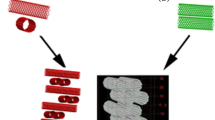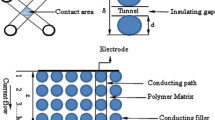Abstract
Carbon nanotubes (CNTs) were prepared using Alcholic Catalyst Chemical Vapor Deposition (ACCVD) technique in order to investigate the effects of their addition on the optical, electrical and mechanical properties of Poly(3-octylthiophene-2,5-diyl) (P3OT) matrix. The absorption spectra of the prepared CNTs and CNT-P3OT nanocomposites were measured in the spectral range 200 nm–3,000 nm at room temperature. The optical energy gap was determined from the obtained UV/Vis absorption spectrum. Optical results reveal that the prepared CNTs are almost single walled. Besides, the addition of CNTs to P3OT polymer matrix will decrease the optical energy gap and enhance the optical absorbance of P3OT matrix. On the other hand, the addition of CNTs to P3OT matrix will increase the electrical conductivity of P3OT matrix up to four orders of magnitude above the percolation threshold (0.44 wt% CNTs). Additionally, I–V characteristics indicate that the conduction mechanism is Ohmic at low applied voltage range while it is due to the trap charge limited at high applied voltage range. Furthermore, the behavior of dc conductivity with temperature was also investigated and the obtained results reveal that the activation energy decreases with CNTs content. Finally, mechanical results reveal that the elastic modulus values increase with the increasing of CNTs content in P3OT matrix.














Similar content being viewed by others
References
Koizhaiganova RB, Kim HJ, Vasudevan T, Lee MS (2009) Double-walled carbon nanotube (DWCNT)-poly (3-octylthiophene)(P3OT) composites: electrical, optical and structural investigations. Synth Met 159(23–24):2437–2442
Qiao Q, Beck J, Lumpkin R, Pretko J, Mcleskey JT (2006) A comparison of fluorine tin oxide and indium tin oxide as the transparent electrode for P3OT/TiO2 solar cells. Sol Energ Mater Sol Cell 90(7–8):1034–1040
Palacios Lidón E, Perez García B, Abellán J, Miguel C, Urbina A, Colchero J (2006) Nanoscale characterization of the morphology and electrostatic properties of poly (3 octylthiophene)/graphite nanoparticle blends. Adv Funct Mater 16(15):1975–1984
Xu B, Dang S, Han P, Chi M, Liu G, Liu X (2006) Band gaps of two-dimensional photonic crystal structure using conjugated polymer (3-octylthiophenes). Opt Commun 267(2):362–366
Zhokhavets U, Goldhahn R, Gobsch G, Schliefke W (2003) Dielectric function and one-dimensional description of the absorption of poly (3-octylthiophene). Synth Met 138(3):491–495
Kazukauskas V, Pranaitis M, Cyras V, Sicot L, Kajzar F (2008) Negative mobility dependence on electric field in poly (3-alkylthiophenes) evidenced by the charge extraction by linearly increasing voltage method. Thin Solid Films 516(24):8988–8992
Spanggaard H, Krebs FC (2004) A brief history of the development of organic and polymeric photovoltaics. Sol Energ Mater Sol Cell 83(2–3):125–146
Solís JC, De la Rosa E, Cabrera EP (2006) Absorption and refractive index changes of poly (3-octylthiophene) under NO 2 gas exposure. Opt Mater 29:167–172
Krinichnyi V, Demianets Y, Mironova S (2008) Charge transfer in poly (3-octylthiophene) modified by fullerene derivative. Physica E: Low-dimensional Syst Nanostructure 40(8):2829–2833
Monedero MA, Luengo GS, Moreno S, Ortega F, Rubio RG, Prolongo MG, Masegosa RM (1999) Calorimetric and dielectric study of a blend containing a conductive polymer: poly (3-octylthiophene) + poly (ethylene-co-vinylacetate). Polymer 40(21):5833–5842
Nicho M, Hernández F, Hu H, Medrano G, Guizado M, Guerrero J (2009) Physicochemical and morphological properties of spin-coated poly (3-alkylthiophene) thin films. Sol Energ Mater Sol Cell 93(1):37–40
Valentini L, Armentano I, Biagiotti J, Marigo A, Santucci S, Kenny J (2004) AC conductivity of conjugated polymer onto self-assembled aligned carbon nanotubes. Diam Relat Mater 13(2):250–255
Lopez-Mata C, Nicho M, Hu H, Cadenas-Pliego G, García-Hernández E (2005) Optical and morphological properties of chemically synthesized poly3-octylthiophene thin films. Thin Solid Films 490(2):189–195
Kymakis E, Alexandou I, Amaratunga G (2002) Single-walled carbon nanotube-polymer composites: electrical, optical and structural investigation. Synth Met 127(1–3):59–62
Cao Y, Liu Z, Gao X, Yu J, Hu Z (2011) Dynamic rheological properties and microstructures of liquid-crystalline poly (p-phenyleneterephthalamide) solutions in the presence of single-walled carbon nanotubes. J Polym Res 18(2):263–271
Kim SD, Kim JW, Im JS, Kim YH, Lee YS (2007) A comparative study on properties of multi-walled carbon nanotubes (MWCNTs) modified with acids and oxyfluorination. J Fluor Chem 128(1):60–64
Meng H, Sui G, Fang P, Yang R (2008) Effects of acid-and diamine-modified MWNTs on the mechanical properties and crystallization behavior of polyamide 6. Polymer 49(2):610–620
Kymakis E, Amaratunga G (2003) Photovoltaic cells based on dye-sensitisation of single-wall carbon nanotubes in a polymer matrix. Sol Energ Mater Sol Cell 80(4):465–472
Spitalsky Z, Tasis D, Papagelis K, Galiotis C (2010) Carbon nanotube-polymer composites: chemistry, processing, mechanical and electrical properties. Prog Polym Sci 35(3):357–401
Murakami Y, Miyauchi Y, Chiashi S, Maruyama S (2003) Direct synthesis of high-quality single-walled carbon nanotubes on silicon and quartz substrates. Chem Phys Lett 377(1–2):49–54
Unalan HE, Chhowalla M (2005) Investigation of single-walled carbon nanotube growth parameters using alcohol catalytic chemical vapour deposition. Nanotechnology 16:2153
Ayesh AS (2010) Electrical and optical characterization of PMMA doped with Y 0.0025 Si 0.025 Ba 0.9725 (Ti (0.9) Sn 0.1) O 3 ceramic. Chin J Polym Sci 28(4):537–546
Jeong MS, Byeon CC, Cha OH, Jeong H, Han JH, Choi YC, An KH, Oh KH, Kim KK, Lee YH (2008) Purity measurement of single-walled carbon nanotubes by UV–VIS-NIR absorption spectroscopy and thermogravimetric analysis. Nano 3(2):101
Kim DY, Yun YS, Bak H, Cho SY, Jin HJ (2010) Aspect ratio control of acid modified multiwalled carbon nanotubes. Curr Appl Phys 10(4):1046–1052
Chen D, Sasaki T, Tang J, Qin LC (2008) Effects of deformation on the electronic structure of a single-walled carbon nanotube bundle. Physical Review B 77(12):125412
Ayesh AS, Abdel-Rahem RA (2008) Optical and electrical properties of polycarbonate/MnCl2 composite films. J Plast Film Sheet 24(2):109
Burrows P, Bulovic V, Forrest S, Sapochak L, McCarty D, Thompson M (1994) Reliability and degradation of organic light emitting devices. Appl Phys Lett 65(23):2922–2924
Antoniadis H, Abkowitz M, Hsieh B (1994) Carrier deep trapping mobility lifetime products in poly (p phenylene vinylene). Appl Phys Lett 65(16):2030–2032
Shen Z, Burrows PE, Bulovic V, McCarty DM, Thompson ME, Forrest SR (1996) Temperature dependence of current transport and electroluminescence in vacuum deposited organic light emitting devices. Jpn J Appi Phys 35:L401–L404
Blom P, De Jong M, Vleggaar J (1996) Electron and hole transport in poly (p phenylene vinylene) devices. Appl Phys Lett 68(23):3308–3310
Burrows P, Shen Z, Bulovic V, McCarty D, Forrest S, Cronin J, Thompson M (1996) Relationship between electroluminescence and current transport in organic heterojunction light emitting devices. J Appl Phys 79(10):7991–8006
Campos R, Kovalev I, Guo Y, Wakili N, Skotheim T (1996) Red electroluminescence from a thin organometallic layer of europium. J Appl Phys 80(12):7144–7150
Abkowitz M, Facci J, Rehm J (1998) Direct evaluation of contact injection efficiency into small molecule based transport layers: influence of extrinsic factors. J Appl Phys 83:2670
Musa I, Eccleston W, Higgins S (1998) Further analysis of space-charge-limited currents in polybenzo [c] thiophene films. J Appl Phys 83:5558
Bunakov A, Lachinov A, Salikhov R (2004) Current voltage characteristics of thin poly (biphenyl 4 ylphthalide) films. Wiley Online Library, p 387–392
Abu Abdeen M, Ghani S (2001) Swelling and electrical properties of rubber vulcanizates loaded with paraffin wax. J Appl Polym Sci 81(13):3169–3177
Wang S, Liang Z, Gonnet P, Liao YH, Wang B, Zhang C (2007) Effect of nanotube functionalization on the coefficient of thermal expansion of nanocomposites. Adv Funct Mater 17(1):87–92
Bauwens Crowet C, Bauwens J, Homes G (1969) Tensile yield stress behavior of glassy polymers. J Polymer Sci Part A 2: Polymer Physics 7(4):735–742
Rubatat L, Gebel G, Diat O (2004) Fibrillar structure of Nafion: matching fourier and real space studies of corresponding films and solutions. Macromolecules 37(20):7772–7783
Van der Heijden P, Rubatat L, Diat O (2004) Orientation of drawn Nafion at molecular and mesoscopic scales. Macromolecules 37(14):5327–5336
Liu D, Kyriakides S, Case SW, Lesko JJ, Li Y, McGrath JE (2006) Tensile behavior of Nafion and sulfonated poly (arylene ether sulfone) copolymer membranes and its morphological correlations. J Polymer Sci, Part B: Polymer Phys 44(10):1453–1465
Acknowledgements
The authors acknowledge the King Abdelaziz City for Science and Technology (KACST), Saudi Arabia for funding and providing the facilities required for this investigation.
Author information
Authors and Affiliations
Corresponding author
Rights and permissions
About this article
Cite this article
Abu-Abdeen, M., Ayesh, A.S. & Al Jaafari, A.A. Physical characterizations of semi-conducting conjugated polymer-CNTs nanocomposites. J Polym Res 19, 9839 (2012). https://doi.org/10.1007/s10965-012-9839-z
Received:
Accepted:
Published:
DOI: https://doi.org/10.1007/s10965-012-9839-z




